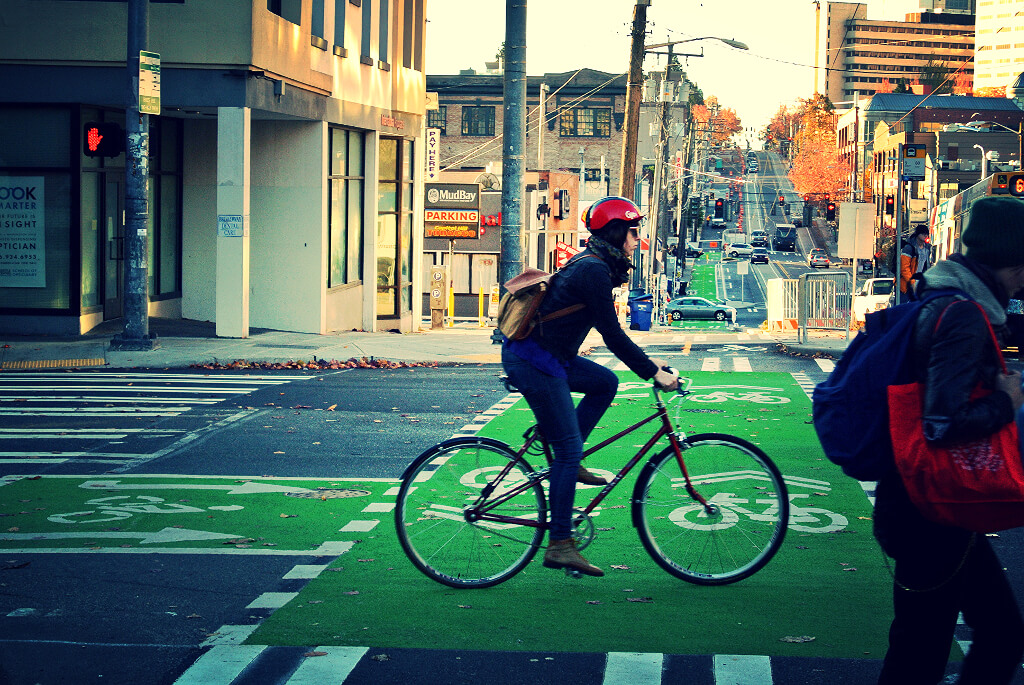Autumn Gear Guide
Find inspiration in our Gear Guide that will keep you out on your bike through wind or rain.
Download NowThe Federal Highway Administration clarifies their support for bike infrastructure across the US.

Photo by SDOT Photos
The Federal Highway Administration (FHWA) has made itself very clear in a report released August 20, 2015: Please use FHWA money to build protected bike lanes! There have been a number of misconceptions in regards to the use of federal funding for the use of non-motorized projects. In the report released, the FHWA cleared up all the confusion by focusing on three key policy areas: Funding, Design, and Environmental Review.
The U.S. Department of Transportation (DOT) has been working to address non-motorized safety issues nationwide with the launch of the Safer People, Safer Streets Initiative in 2014. From the time of its launch, the DOT has been engaging with safety experts, local officials, and the public on the subject of targeting strategies to encourage safety for cyclers and pedestrians. It is, perhaps, due to these discussions that confusion resulted.
A lot of people have been complaining that State and local DOTs resort to a bunch of excuses to avoid certain construction designs such as protected bike lanes. A popular justification is “the feds won’t fund that.” The FWHA wants you to know: This is false.
First off, federal funds can be used to build protected bike lanes. One misconception is that the Transportations Alternatives Program (TAP) is the only federal funding source for pedestrian and bicycle projects, which is absolutely false. While TAP is a popular source of funding for such projects, pedestrian and cycling projects are eligible for FHWA funding through Congestion Mitigation and Air Quality Improvement (CMAQ) Program, Federal Transit Administration (FTA), the National Highway Performance Program, as well as many more programs outlined in the published FWHA report.
If there is any more doubt as to whether federal funds can be used to plan and build separated bike lanes (which can also include cycle tracks), the FHWA recently published a Separated Bike Lane Planning and Design Guide that also outlines the use of road diets as a Proven Safety Countermeasure.
Another misconception the FWHA wants to address is that the American Association of State Highway and Transportation (AASHTO) Green Book is the only design standard that can be used on Federal-aid highway projects. Again, this is false. The Green Book provides flexibility of design – when a Green Book standard applies but an element of the design is outside of the parameters, an exception can be considered.
Also stated in the report is that vehicle lanes do not have to be a certain width to receive federal funds. In fact, research has shown that narrower lanes (10 feet vs the new American standard of 12 feet) are actually much safer than wide lanes and result in a negligible reduction in traffic volume capacity, if any at all.
Hopefully, the new report has clarified elements of the existing policies that enable and encourage transportation planners around the country to move forward on progressive transportation projects. Regardless, the FHWA has made one thing very clear: the FHWA supports federal funds going towards bicycling and pedestrian projects that reduce crash rates, increase the livability of cities, and improve air quality. And those are projects we can get behind too.
Find inspiration in our Gear Guide that will keep you out on your bike through wind or rain.
Download Now
Worth noting, though, that FHWA is also busy reminding cities that some Federal standards still are mandatory — MUTCD requirements still trump anything in AASHTO, NACTO, or the Separated Bike Lane Planning and Design Guide. That includes requirements to abide by the “request to experiment” process for un-approved traffic controls.
Common bike infrastructure that is still experimental and still requires FHWA pre-approval includes bike boxes, two-stage turn boxes, and dashed/”advisory” bike lanes.
FHWA has also pointed out a number of treatments recommended by NACTO that are expressly prohibited by MUTCD.
“Design flexibility” applies to geometric design (AASHTO Green Book), not to signs, signals, and striping (MUTCD compliance is mandatory under Federal code.)
http://www.fhwa.dot.gov/environment/bicycle_pedestrian/guidance/design_guidance/mutcd/
Comments are closed.